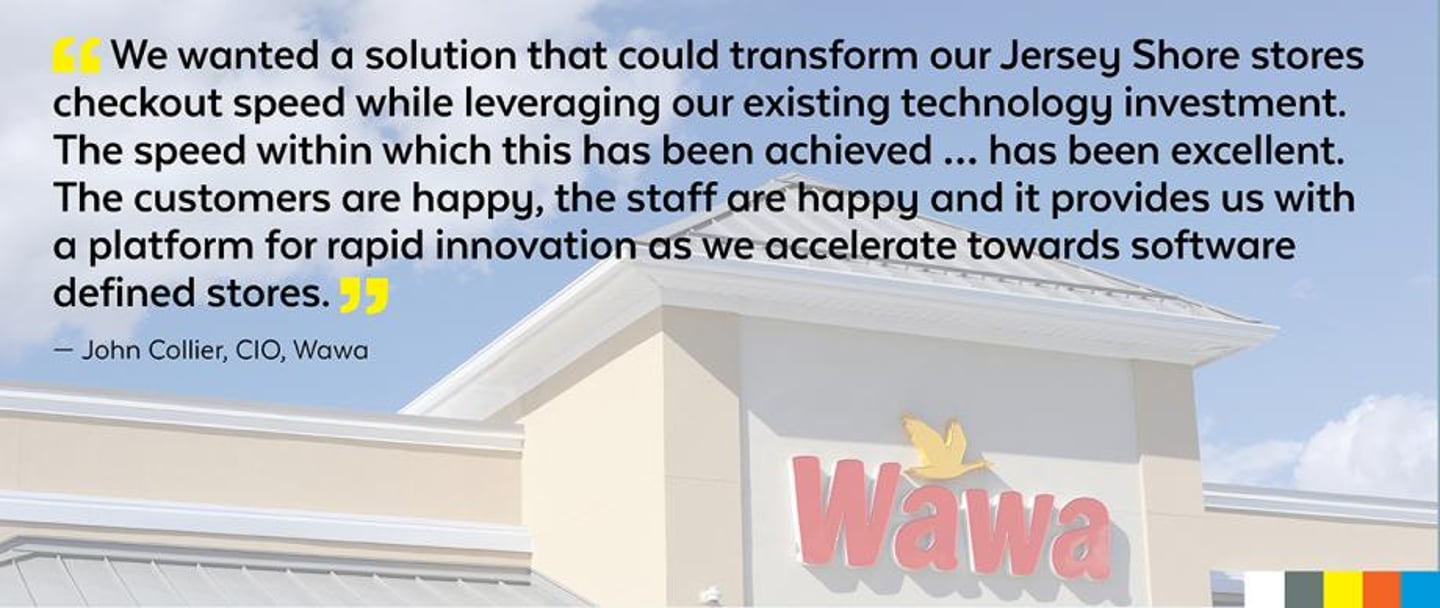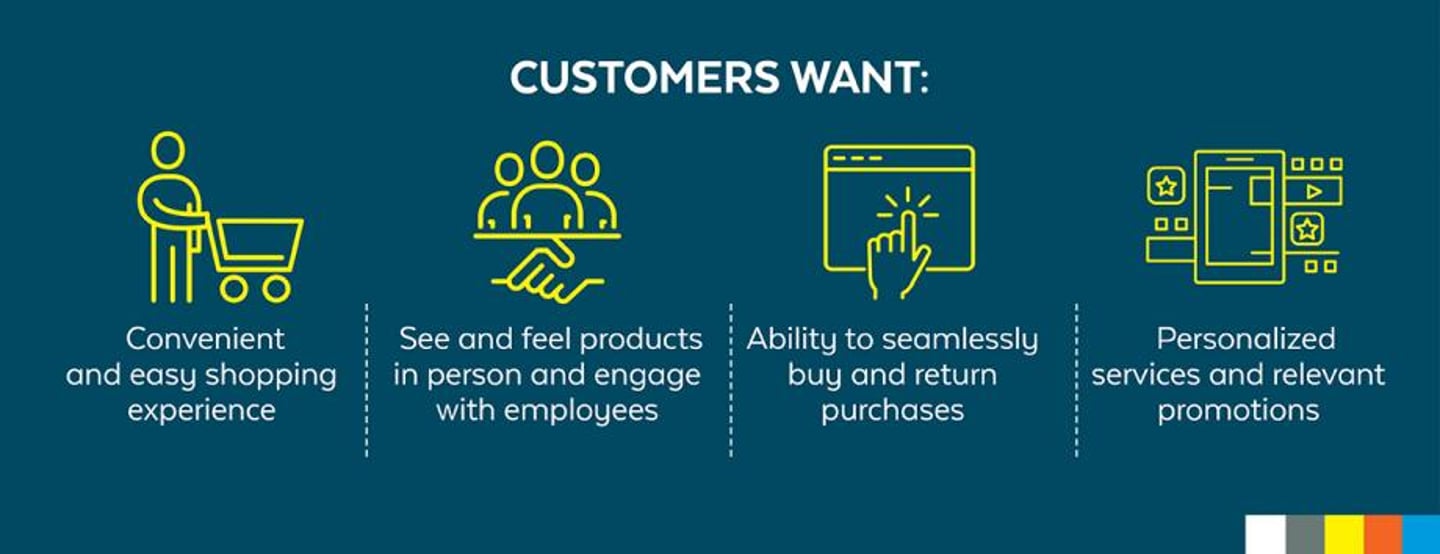Modernize Your In-Store Infrastructure to Compete in an Evolving Marketplace
Over the years, many retailers have under-invested in their in-store technology and are now backed into a corner. Dealing with legacy IT infrastructures in-store can be overly complex and expensive to maintain, and the hardware and software can be so outdated that it is too patched together to work properly.
Finding a fix is imperative. Retail executives must decide if patching their in-store infrastructure and sticking to what they know, is ideal, or if ripping it all out and starting over, is the answer.
Most retailers know they are in need of an in-store IT infrastructure overhaul to keep up with changing consumer preferences, new store formats, and other technological advancements influencing the industry, but finding the right upgrade strategy can be a challenge. Using software to define and remotely manage the store infrastructure can help – similar to how savvy retailers utilize network or desktop virtualization today.
Read on to uncover the four steps retailers should follow to successfully modernize their in-store infrastructures and remain competitive for years to come – without breaking the bank.
Despite the ongoing digital transformation, the brick-and-mortar store is still of upmost importance to consumers as they want to see, feel and try out an item before making a purchase. In fact, eMarketer forecasts that retail e-commerce will account for 10.9% of total US retail spending across all merchants in 2019 — about one-eighth the size of brick-and-mortar retail. So, with the customer preference to shop at physical locations still alive and well, the in-store experience is more important than ever before. It differentiates retailers and allows them to gain shopper loyalty and keep them coming back again and again.
#1 STOP PATCHING LEGACY SYSTEMS
The growth and maturation of omnichannel practices has created a frictionless, engaging and personalized shopping experience online, leaving consumers with the desire to achieve the same level of experience at the store level. Simply put, they want technology to make their shopping experience more convenient. But traditional in-store IT infrastructures cannot support the seamless shopper journey if they are disjointed, outdated and not scalable. While patching may have been the answer to keeping these systems up and running in the past, legacy systems with numerous patches are not capable of keeping pace.
Each legacy infrastructure can contain back office and front-end systems such as POS terminals, kitchen ordering systems, payment controllers, inventory systems, loyalty systems, etc. With traditional hardware-heavy, in-store technology, a new implementation like a tablet-based POS to accelerate checkout during a rush, or a new loyalty program, can be a costly hassle.
Further, with legacy systems, patches are often released to help protect against vulnerabilities. Since IT can’t necessarily test the stability or effectiveness of each patch, and know that it can impact operations if there’s downtime – many companies simply don’t apply them. As each new patch is released, it becomes too expensive or too complex to implement and the legacy system falls behind, becomes a security risk, or worse, becomes obsolete.
Multiply these patches and upgrades by each network, POS lane, piece of hardware, operating system and application ― and the time and money to address it becomes overwhelming. So while the purpose of applying patches can make sense in the short-term, it is not a long-term fix for future-proofing in-store technology investments.
#2 DECOUPLE YOUR SOFTWARE AND HARDWARE
Patching and updating legacy systems is not a viable long-term solution, so how can retailers move forward quickly without breaking the bank?
It’s important to avoid the other false choices that can bubble to surface during an upgrade. Immediately jumping to the cloud may seem like a viable option, but the existing infrastructure may still not support that move. More modern applications typically require local- or store-level data, and the legacy systems can bring about more latency or connectivity issues. Others may suggest a rip-and-replace method, however it can be a bigger risk than its worth – there are significant business impacts (such as downtime) to consider for consumers and associates alike.
However, retailers can tackle the problem by using their existing IT infrastructure to compete through virtualization. This strategy reduces the physical IT footprint in-store by moving endpoint technologies to an edge server that offers a singular point of control across sites, and securely connects users and peripherals to in-store applications. It breaks the reliance between software and hardware, enabling IT executives to make hardware decisions that are independent from software, creating a more agile and centralized system. For example, Wawa virtualizes its existing hardware (like the POS terminal) from the software that runs on it, so they no longer have to depend on each other. By doing this, retailers can implement new solutions and technologies without worrying about the state of the hardware, end-of-life issues or compliance.
The virtualized server moves the software from the terminals and systems in each lane so the scanners, scales, printers, cash drawers, MSRs, etc., can continue to operate without the software being not local to that touchpoint. When moving to the virtual server on a cloud-enabled control platform, retailers can gain:
- Reduced physical IT footprint in store
- Centralized management, updates and control of the entire store as a single touchpoint instead of system by system
- Infrastructure services such as file management, firewall, user management, secure networking and systems back-up
- Performance improvement of older hardware for longer use, extending the life of those investments
- Ability to add more technology innovation and newer, thinner hardware (i.e. tablets)
- Ability to integrate multiple hardware/software systems due to M&As
By embracing virtualization, retailers are freed up to make the right technology investments for their needs without the rush of patches and the complexity of rip and replace, all with more control, agility and lower costs.
#3 FOCUS ON THE UPGRADE
Once the hardware and software are no longer dependent on each other, the next step is to focus on the software upgrades at your own pace. By eliminating the reliance on each other, retailers can look to newer software faster (and without extra costs), investing in the technologies that will allow them to remain agile and deliver the best consumer experience today and going forward.
Implementing and upgrading the software can also serve as a discovery process, showing retailers what other issues they can solve such as improving loyalty systems. However, retailers cannot interpret this as a replacement scenario from buying software. The real value comes from deciding the right strategy and the right software going forward, and how it will work best with the hardware investments. It doesn’t just solve today’s problem, but puts retailers on a path to modernizing the store for every future project, helping them understand their biggest pain points and how to achieve the best value from a flexible infrastructure.
The speed of change in retail stores is only going to increase. New technologies are introduced to the industry constantly and consumers are quick to adapt and use them as long as they make the shopper journey more convenient. In order to keep those consumers, it’s imperative for retailers to modernize their software in a flexible way that can keep up with the pace of change, or they risk falling behind.
#4 TAKE FULL ADVANTAGE OF MODERNIZATION
Investing in a software defined approach to modernizing technologies in-store can help improve the consumer experience and accelerate future innovation, while reducing costs. What’s more, when ready, retailers can migrate to the cloud and further take advantage of bridging the physical and digital gap.
One such company making a case for this strategy is the aforementioned Wawa, which is applying a digital integration strategy to modernizing its checkout system using software to create a virtualization layer for its POS platform. This allows associates to roam stores and complete sales with a tablet computer, according to Wawa CIO John Collier.
This approach not only helps bust checkout lines but also enables Wawa to rapidly add newer technology. “Such automation will also ideally free store associates up to spend more time catering to customers, a key aspect of Wawa’s culture,” Collier said.
The company’s strategy dubbed ‘boundless convenience’ aims to enhance Wawa’s relationship with people and ‘back it up with technology to make interactions more seamless and robust,’ according to Collier – earning it the ‘2017 Foodservice Innovator of the Year’ recognition from Convenience Store News.
DON’T LET LEGACY SYSTEMS SLOW YOU DOWN
As quickly as the retail technology landscape is changing and evolving, so too must in-store IT infrastructures. That’s because the future of the store is still the most critical and profitable channel for retailers surveyed by RSR Research, “but that doesn’t mean that the format will remain the same.” The in-store experience needs to be more targeted, focused, relevant, and fun – as RSR notes it is a very specific experience, and retailers know it has to change.
It’s time for retail to start making longer term IT investments that will future-proof their legacy systems so they can adopt and change as quickly as consumer preferences. Remaining flexible and agile with software and hardware in the store allows for associates to spend more time and resources on improving and differentiating the consumer experience, as well as the opportunity to experiment with new technologies. Traditional IT infrastructures just won’t cut it if stores are going to remain competitive not only today, but tomorrow.









